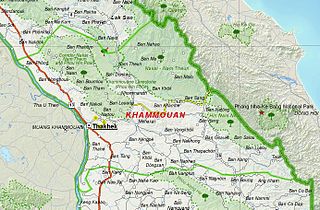
The Phra Bang ," Lao is the palladium of Laos. The Lao-language name for the image has been transliterated in a number of ways, including "Pra Bang," "Prabang," "Phabang" and "Pha Bang." The statue is an 83 cm-high standing Buddha with palms facing forward, cast using thong, an alloy of bronze, gold, and silver. According to local lore, it was cast in Ceylon sometime between the 1st and 9th century. However, the features of the image suggest a much later Khmer origin.

Kanchanaburi is the largest of the western provinces (changwat) of Thailand. The neighboring provinces are Tak, Uthai Thani, Suphan Buri, Nakhon Pathom, and Ratchaburi. In the west it borders Kayin State, Mon State, and the Tanintharyi Region of Myanmar.

Near Pak Ou the Tham Ting and the Tham Theung are caves overlooking the Mekong River, 25 km to the north of Luang Prabang, Laos. They are a group of two caves on the west side of the Mekong river, about two hours upstream from the centre of Luang Prabang, and are frequently visited by tourists.

The Xe Bang Fai River or Nam Xebangfai is a river of Laos.

Tham Kong Lo or Kong Lor Cave is a karst limestone cave in Phu Hin Bun National Park, in Khammouane Province, Laos. It is located roughly 130 kilometres (81 mi) north of Thakhek, on the Nam Hin Bun River, which flows into the cave. The karst formation is dramatic and the cave has been cited as a "one of Southeast Asia's geological wonders".

Ban Pakpo, also Pak Pok or Pakpo, is a village in Vientiane Province, Laos. It is located north along Route 13 from Vang Vieng, not far from the eastern bank of the Nam Song River. To the northwest of the village is the Tham Pha Thao cave and the Tham Sang Triangle of four caves.
The Tham Sang Triangle refer to a group of four caves in close proximity, located roughly 8 kilometres (5.0 mi) north of Vang Vieng, Laos, to the northwest of the village of Ban Pakpo. The four caves are Tham Sang, Tham Hoi, Tham Loup, and Tham Nam. The name "Tham Sang" refers to the stalactites within them which are said to resemble elephants, a characteristic in particular of the Tham Sang cave. The entrance has a grey boulder on the right side with a red flower bush beyond that. Tham Hoi is considered the most sacred to locals, with a larger Buddha head in the entrance, whilst Tham Loup is noted for its stalactites. Tham Nam, meaning "water cave", is located roughly 400 metres (1,300 ft) south of Tham Hoi.
Tham Phu Kham is a cave to the northwest of Vang Vieng, Laos, located just to the northeast of the village of Ban Na Thong. Its name means "Blue Lagoon" due to its blue waters. The cave is revered by the locals and contains several Buddha images. The largest is a reclining bronze Thai Buddha in the main cave.
Buddha cave may refer to many caves in Asia which are noted for their Buddha statues:

Vientiane Province is a province of Laos, located in the northwest of the country. As of 2015 the province had a total population of 419,090 people. Vientiane Province is a large province, covering an area of 15,927 square kilometres (6,149 sq mi) with 10 districts in mid north-western Laos. The province borders Luang Prabang Province to the north, Xiangkhouang Province to the northeast, Bolikhamxai Province to the east, Vientiane Prefecture and Thailand to the south, and Xaignabouli Province to the west. The principal towns are Vang Vieng and Muang Phôn-Hông. Several kilometres to the south of Vang Vieng is one of Laos's largest lakes, Nam Ngum. Much of this area, particularly the forests of the southern part, are under the Phou Khao Khouay National Bio-Diversity Conservation Area. The principal rivers flowing through the province are the Nam Song River, Nam Ngum River and the Nam Lik River.

Houaphanh province is a province of eastern Laos. As of 2015 it had a population of 289,393 people. Its capital lies at Sam Neua.

Khammouane or Khammouan is a province of Laos, located in the center of the country. Its capital lies at Thakhek.

Sainyabuli Province is a province in northwest Laos. Sainyabuli town is the capital of the province. Sainyabuli is the only Lao province that is completely west of the Mekong River.

Vientiane or Viengchan is a prefecture of Laos, located in the north-west of the country. The national capital, Vientiane, is located in the prefecture. The prefecture was created in 1989, when it was split off from Vientiane Province.

Champasak is a province in southwestern Laos, near the borders with Thailand and Cambodia. It is one of the three principalities that succeeded the Lao kingdom of Lan Xang. As of the 2015 census, it had a population of 694,023. The capital is Pakse, but it takes its name from Champasak, the former capital of the Kingdom of Champasak.

The Tiger Cave Temple is a Buddhist temple north-northeast of Krabi, Thailand. A sacred site, it is known for the tiger paw prints in the cave, tall Buddha statues and the strenuous flight of stairs to reach the summit.

Khuean Srinagarindra National Park is a national park in Kanchanaburi Province, Thailand. The park, centred on the Srinagarind Reservoir, is part of the Western Forest Complex protected area.

Phu Pha Thoep National Park, formerly known as Mukdahan National Park, is a national park in Mukdahan Province, Thailand. This park, one of the country's smallest national parks, is home to unusual rock formations and a cave with ancient hand paintings.

Tham Pla–Namtok Pha Suea National Park is a national park in Mae Hong Son Province, Thailand. It is home to caves, waterfalls and steep mountain terrain.
The following lists events that happened during 2004 in Laos.
















